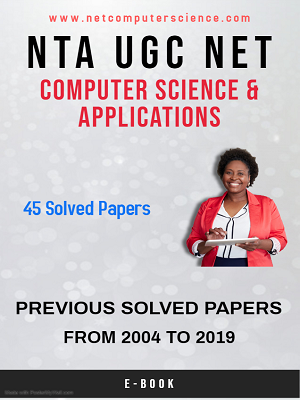21. Let
n=4 and (a1, a2, a3, a4) = (do, if,
int, while). Let p(1:4) = (3/8, 3/8, 1/8, 1/8) and q(1:4) = (2/8, 3/8, 1/8,
1/8, 1/8) where p(i) and q(i) denotes the probability with which we search ai
and the identifier x being searched satisfy ai < x < ai+1
respectively. The optimal search tree is given by:
Answer:
B
22. The
family of context sensitive languages is ................. under union and .................
under reversal.
(A) closed,
not closed (B) not
closed, not closed
(C) closed,
closed (D) not closed,
closed
Answer:
C
23. Match
the following :
List
- I List - II
(a) {an
bn|n > 0} is a deterministic (i)
but not recursive language
context free language
(b) The
complement of {an bn an|n > 0} (ii) but not context free language
is
a context free language
(c)
{an bn an} is context sensitive language (iii) but can not be accepted by a
deterministic pushdown automation
(d)
L is a recursive language (iv)
but not regular
Codes
:
(a) (b) (c)
(d)
(A) (i) (ii) (iii)
(iv)
(B) (i) (ii) (iv)
(iii)
(C) (iv)
(iii) (ii) (i)
(D) (iv)
(iii) (i) (ii)
Answer:
Marks to all
24. The
language of all non-null strings of a’s can be defined by a context free
grammar as
follow :
S→a S|S a| a
The word a3
can be generated by ................ different trees.
(A) Two (B) Three
(C) Four (D) Five
Answer:
C
Explanation:
25. Which
one of the following non-functional quality attributes is not highly affected
by the
architecture
of the software ?
(A)
Performance (B) Reliability
(C)
Usability (D) Portability
Answer:
C
26. The
context free grammar given by
S→XYX
X→aX|bX|λ
Y→bbb
generates
the language which is defined by regular expression:
(A) (a+b)*bbb
(B) abbb(a+b)*
(C)
(a+b)*(bbb)(a+b)* (D)
(a+b)(bbb)(a+b)*
Answer:
C
27. There
are exactly ................ different finite automata with three states x, y
and z over the alphabet {a, b} where x is always the start state.
(A) 64 (B) 256
(C) 1024 (D) 5832
Answer:
D
28. Given
the following two languages :
L1={anban|n>0}
L2={anbanbn+1|n>0}
Which of the
following is correct?
(A) L1
is context free language and L2 is not context free language
(B) L1
is not context free language and L2 is context free language
(C) Both L1
and L2 are context free languages
(D) Both L1
and L2 are not context free languages
Answer:
A
29. Which
of the following is used to make an Abstract class ?
(A) Making
atleast one member function as pure virtual function
(B) Making
atleast one member function as virtual function
(C)
Declaring as Abstract class using virtual keyword
(D)
Declaring as Abstract class using static keyword
Answer:
A
30. Match
the following with reference to object oriented modelling :
List
- I List - II
(a)
Polymorphism (i) Picking both
operator and attributes with
operations
appropriate to model an object
(b)
Inheritance (ii)
Hiding implementation details of methods
from
users of objects
(c)
Encapsulation (iii) Using similar
operations to do similar things
(d)
Abstraction (iv) Create new
classes from existing class
Codes :
(a) (b) (c)
(d)
(A) (iv) (iii) (i)
(ii)
(B) (iii) (iv) (i)
(ii)
(C) (iii) (i) (ii)
(iv)
(D) (iv) (iii) (ii)
(i)
Answer:
B










1 Comments
great
ReplyDelete